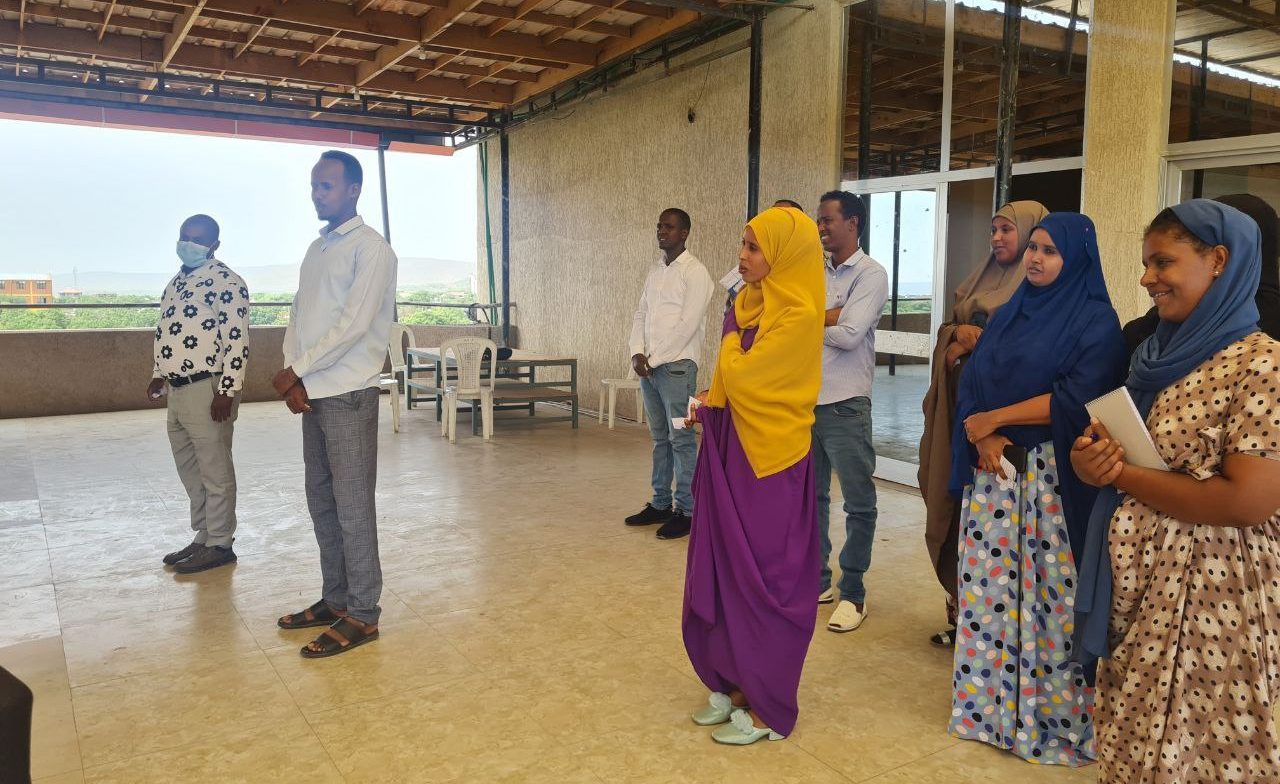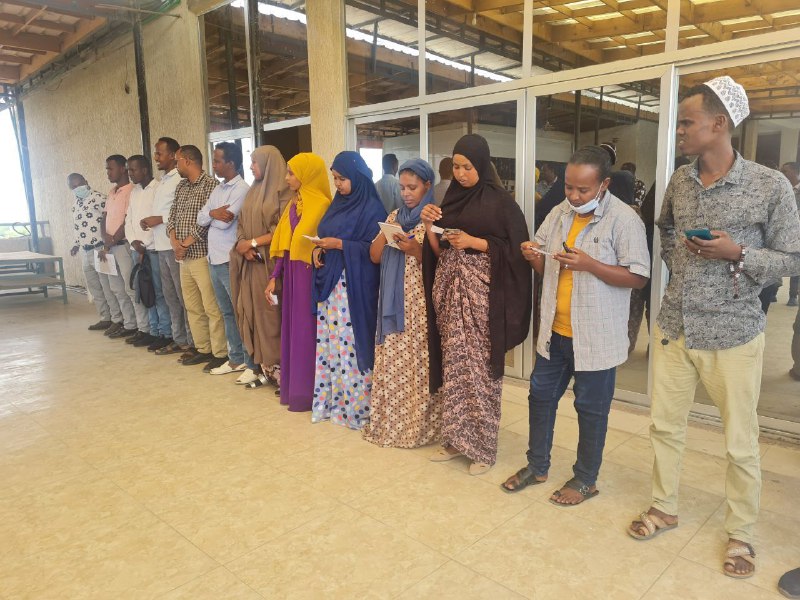
Taking part in a Power Walk which aims to challenge participants' preconceptions about power dynamics and social hierarchies within communities pre-, during and post-disaster .
Unveiling new perspectives in public health emergency management: integrating gender equality and social inclusion in vulnerability risk mapping and emergency planning
25 July 2023
In this blog post, Bezawit Demisse and Bella Roman of Oxford Policy Management (OPM) describe the way that gender equality and social inclusion (GESI) were considered in work on Public Health in Emergency Management as part of OPM’s Building Resilience in Ethiopia programme [opens new tab].
Disasters and public health emergencies have unequal effects. Gender relations and inequities and other social dimensions and power divisions create different needs and vulnerabilities, such that people are affected to different degrees and in different ways by shocks such as drought, disease outbreaks and conflict. Consequently, gender equality and social inclusion (GESI) are crucial considerations for disaster and emergency management, and understanding the diverse needs, perspectives, and experiences of all individuals and groups is vital for effective and inclusive programming. This blog describes the way that GESI was considered in work on Public Health in Emergency Management (PHEM) as part of the Building Resilience in Ethiopia programme.
The Ethiopian context
In Ethiopia, recent decades have witnessed a marked rise in the number, severity and impact of climatic and humanitarian disasters on vulnerable people. The last few years have been particularly challenging, with internal conflict, locust invasions damaging crops, the COVID-19 pandemic, severe droughts affecting pastoral areas, and now forecasts of heavy rainfalls and floods from El Niño. These crises have a heavy human and economic cost, constraining Ethiopia’s development. They also create severe challenges for an already fragile health system, disrupting and overstretching basic health and other social services.
Despite these conditions severely straining government budgets and ability to respond to shocks, the Government of Ethiopia is pressing ahead with reforms and investments in disaster risk management and climate change adaptation. These reforms aim to develop the integrated systems and institutional capacity needed to prepare for and manage crises efficiently and effectively.
Building resilience in Ethiopia
In support of these efforts, Building Resilience in Ethiopia (BRE) is a four and half year (2019–24) technical assistance project co-funded by UK aid (FCDO) and USAID. The main aim of BRE is to support Ethiopia’s drive towards becoming a middle-income country by strengthening nationally-owned and -led systems that better anticipate and respond to recurrent shocks and resultant acute needs. The BRE vision is in line with the National Disaster Risk Management Policy and will support the Government of Ethiopia to lead and deliver an effective, gradually self-financed, and accountable response to climate and humanitarian shocks.
BRE is being implemented by Oxford Policy Management (OPM) and involves provision of technical assistance across four workstreams, including Public Health Emergencies (PHE), Disaster Risk Management, Shock Responsive Safety Net, and Disaster Risk Finance. BRE’s approach recognizes the importance of gender equality and social inclusion, particularly the ‘double vulnerability’ faced by women and vulnerable groups due to their livelihoods, societal roles, and access to resources and information. Alongside a strong focus on gender, BRE considers dimensions such as disability, household structure, livelihoods, and displacement, and recognises that populations often experience overlapping vulnerabilities and power imbalances that affect vulnerability.
The PHE workstream supports the Federal Ministry of Health (FMOH) and the Ethiopian Public Health Institute (EPHI) and extends technical assistance (TA) to Regional Health Bureaus and Public Health Institutes upon the request of FMOH-EPHI. The aim is to build a resilient health system capable of preparing for and responding to public health and nutrition emergencies, such as infectious diseases, mass causalities, or acute malnutrition from climatic and other disasters. The technical input aims at strengthening capacity of the government system to assess and identify risk, predict, prepare, and prevent likely events, and respond to emergencies faster and effectively to reduce morbidity and save lives. BRE’s PHEM and GESI teams have worked together with the government to integrate GESI within PHEM activities.
What are Vulnerability and Risk Assessment Mapping and Emergency Preparedness and Response Plans?
One area where GESI has been integrated involves support to Vulnerability and Risk Assessment Mapping (VRAM) and risk-informed Emergency Preparedness and Response Plans (EPRP). Changing climatic conditions and other shocks have increased the incidence and dynamicity of hazards including drought and epidemics, making better emergency preparedness essential to reduce population vulnerability. Emergency preparedness planning was already established in Ethiopia but needed strengthening to make more use of evidence and an emergency risk management approach. Ethiopia was also already one of only a small number of countries that conducted VRAM at national and subnational levels, but until 2021 the VRAM-EPRP process had not been used at the more local woreda level. This local EPRP and VRAM is essential because risk profiles vary between geographies, and because woredas are the administrative level at which detection, prevention and response are coordinated.
To address this need, FMOH and EPHI worked in partnership with BRE-TA and regional governments to prepare woreda-level VRAM-EPRPs. These plans identify local public health risks, and aim to strengthen and improve response capacity by establishing the required resources and coordination mechanisms. A series of training events was organised over 2021-23 to support the development of VRAM-EPRPs for the most vulnerable woredas across most of Ethiopia. Woreda selection focused on those most vulnerable to disasters, based on monitoring data and discussion with Regional Health Bureaus or Public Health Institutes.
Training sessions were held in 10 regions and one city administration (Dire Dawa), covering 264 woredas and 560 participants. The sessions were led by EPHI (specifically the PHEM Preparedness and Capacity Development Directorate), with input from respective Regional Health Bureaus or Regional Public Health Institutes, and BRE-TA. Participants came from the regional, zonal and woreda levels, including government PHEM, veterinary, public health and disaster risk management officers. As well as preparing the woreda-level VRAM-EPRPs, the training events focused on developing the skills of regional facilitators so they could lead future training and facilitation, with 75 facilitators now trained.
Breaking new ground: the Power Walk tool
In the past, there has been limited attention to GESI within VRAM and EPRP workshops. To address this, BRE introduced the Power Walk tool, which aims to challenge participants’ preconceptions about power dynamics and social hierarchies within communities pre-, during and post-disaster .
The Power Walk is a group exercise that facilitates participants to ‘walk’ in someone else’s shoes and experience what it feels like to be powerless or powerful based on gender, occupation, education level, disability, age, health or other characteristics, and in the face of different obstacles or shocks.

Starting the power walk
Participants receive different character descriptions related to their gender, age, living conditions and other characteristics. The characters assigned to male participants represent women, and vice versa. Examples include:
- Female, 19 years old, a blind person living alone with no assistance
- Female, 37 years old, HIV-positive, mother of two children, raising her children alone
- Female, 18 years old, orphaned, raising five siblings, selling fruit in the local market for a living
- Male, 38 years old, disabled, single
- Male, 30 years old, educated
- Male, 35 years old, lost his wife, taking care of his three children, making ends meet through labour
Subsequently, all participants stand in a straight line to symbolise the equal human rights granted to everyone from birth. Statements describing activities are then read aloud by the facilitator, and if a person holding a character can access or engage in the mentioned activity, they take a step forward. Examples include “take a step forward if you can access medical services at the nearest clinic, if you can access a bank loan and credit services, if you can influence the community around you, if you can access emergency food distribution sites easily, or if you can travel to an emergency shelter without any help”. As more statements are read, clearly observable disparities emerge with participants standing in different positions, illustrating the varied experiences and challenges encountered by different characters.
The Power Walk exercise helped to shed light on previously overlooked dimensions of PHEM. The exercise sparked discussions and debate among participants and highlighted the need to integrate GESI considerations at all stages of emergency management . It strengthened participants’ understanding of the potential consequences of unintentional exclusion for diverse groups, and the need to consider tailored emergency response strategies to address different vulnerabilities.
Overall, collaboration between the BRE GESI and PHEM teams and the government helped to unveil new perspectives and nurture a more inclusive approach to emergency management. Moving forward, ongoing collaboration, capacity building, and stakeholder engagement are needed to sustain and expand integration of GESI within emergency management. BRE is continuing support through activities such as advice on GESI for VRAM/EPRP training materials, capacity building workshops for trainers to support them in creating more inclusive training material, and input to workshop facilitation. By strengthening integration of GESI within future training and emergency planning, we can work towards a more equitable and inclusive world where no one is left behind in times of crisis.